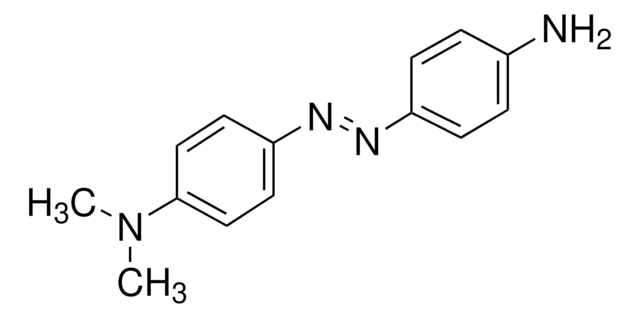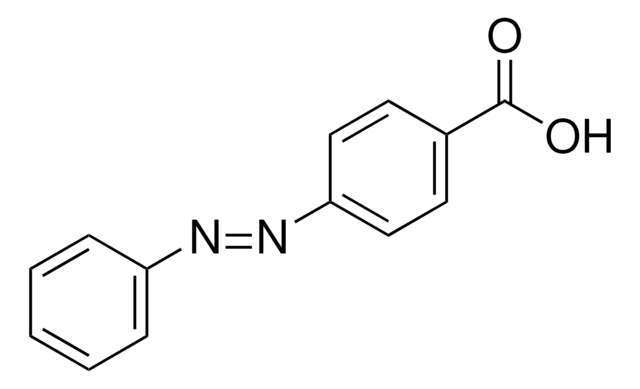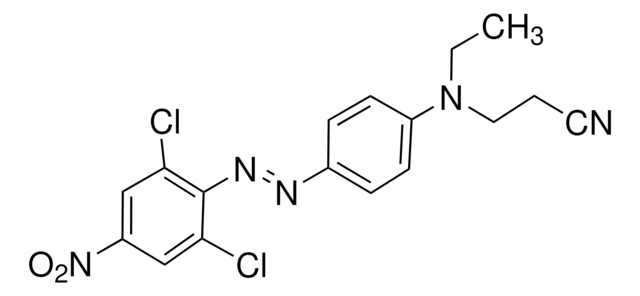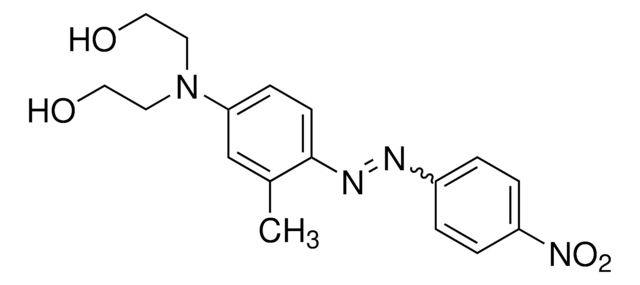모든 사진(2)
About This Item
Linear Formula:
O2NC6H4N=NC6H4NH2
CAS Number:
Molecular Weight:
242.23
색상 지수 번호:
11005
Beilstein:
1842907
EC Number:
MDL number:
UNSPSC 코드:
12352103
PubChem Substance ID:
NACRES:
NA.23
추천 제품
구성
Dye content, 90%
mp
~200 °C (dec.) (lit.)
λmax
443 nm
SMILES string
Nc1ccc(cc1)\N=N\c2ccc(cc2)[N+]([O-])=O
InChI
1S/C12H10N4O2/c13-9-1-3-10(4-2-9)14-15-11-5-7-12(8-6-11)16(17)18/h1-8H,13H2/b15-14+
InChI key
UNBOSJFEZZJZLR-CCEZHUSRSA-N
유사한 제품을 찾으십니까? 방문 제품 비교 안내
일반 설명
Disperse Orange 3 (DO3) is a monoazo dye, which contains 90% dye content plus dispersing agents and surfactants. It has two aromatic rings with an amino group on one of the rings and the other is substituted with a nitro group. It shows an absorption peak majoring at 415 nm.
애플리케이션
DO3 can be used in low concentration to improve the electro-optic properties of dichroic polymer-dispersed liquid crystals, which can be used as materials for display devices. It can also be used to functionalize epoxy-bisazo based polymers, which can be potentially used in sensors and optoelectronics.
특징 및 장점
Used to provide experimental verification of a two-level model for the enhancement of the nonresonant, nonlinear refractive index, with a decrease in absorption by reduction of a donor group strength.
신호어
Warning
유해 및 위험 성명서
Hazard Classifications
Eye Irrit. 2 - Skin Irrit. 2 - Skin Sens. 1 - STOT SE 3
표적 기관
Respiratory system
Storage Class Code
11 - Combustible Solids
WGK
WGK 3
Flash Point (°F)
Not applicable
Flash Point (°C)
Not applicable
개인 보호 장비
dust mask type N95 (US), Eyeshields, Faceshields, Gloves
이미 열람한 고객
Biodegradation of a model azo disperse dye by the white rot fungus Pleurotus ostreatus.
Zhao X, et al.
International Biodeterioration & Biodegradation, 57(1), 1-6 (2006)
A A Ahmad et al.
Journal of hazardous materials, 170(2-3), 612-619 (2009-06-12)
The purpose of this work is to obtain optimal preparation conditions for activated carbons prepared from rattan sawdust (RSAC) for removal of disperse dye from aqueous solution. The RSAC was prepared by chemical activation with phosphoric acid using response surface
Anthony T-J Goon et al.
Contact dermatitis, 48(5), 248-250 (2003-07-19)
Cross-sensitization between para-phenylenediamine (PPD) and Disperse Orange 3 (DO3), among other textile dyes, has frequently been reported. We evaluated the frequency of simultaneous patch test reactions to PPD and a range of textile dyes. Retrospectively, we studied 128 patients who
Laura Malinauskiene et al.
Contact dermatitis, 68(2), 65-75 (2013-01-08)
Several disperse dyes (DDs) are still considered to be the most important allergens in textile dermatitis, but there are sparse data about their current use in textiles. The aim of this review was to evaluate published studies and reports on
Manfred Kneilling et al.
Experimental dermatology, 19(5), 435-441 (2010-02-02)
Patients sensitized to para-phenylenediamine (PPD) by semi-permanent tattoos increasingly develop threatening allergic reactions in response to black hair dye. The gold standard to diagnose allergic contact dermatitis is to perform epicutaneous patch tests, however, iatrogenic sensitizations and severe patch test
자사의 과학자팀은 생명 과학, 재료 과학, 화학 합성, 크로마토그래피, 분석 및 기타 많은 영역을 포함한 모든 과학 분야에 경험이 있습니다..
고객지원팀으로 연락바랍니다.






![4-[4-(Dimethylamino)phenylazo]benzoic acid N-succinimidyl ester ≥98.0% (HPLC)](/deepweb/assets/sigmaaldrich/product/structures/120/235/500b5276-3ce2-43b7-9588-3883f13d4ff7/640/500b5276-3ce2-43b7-9588-3883f13d4ff7.png)



